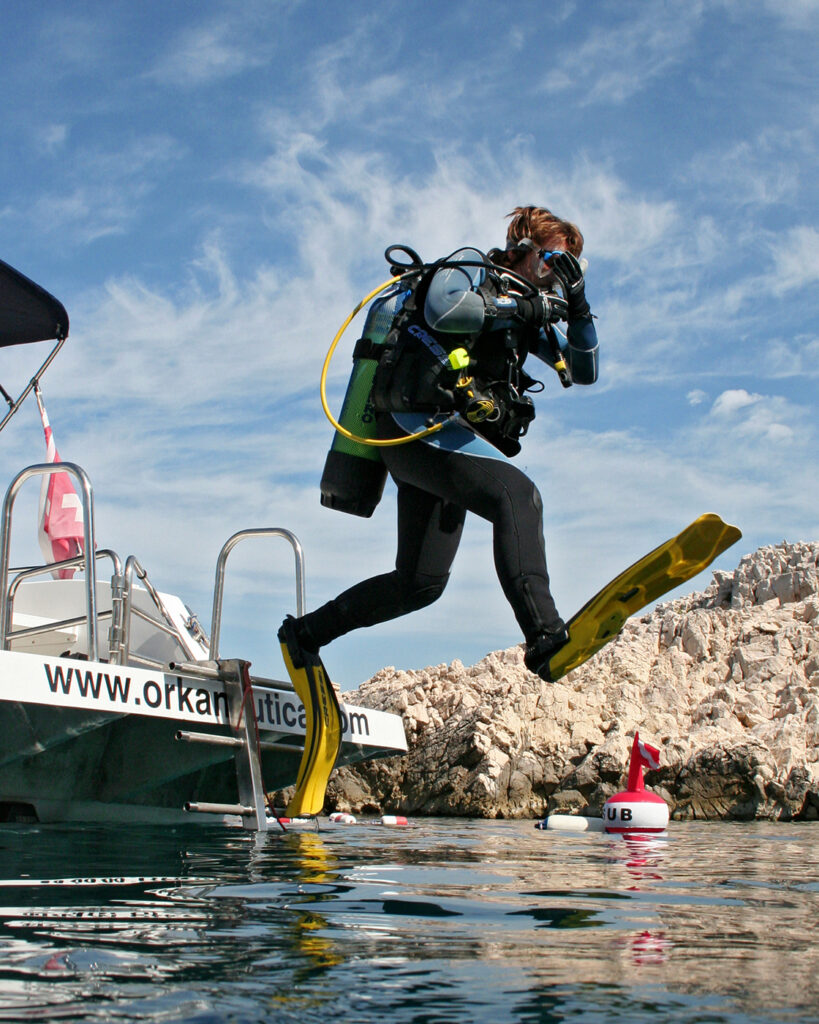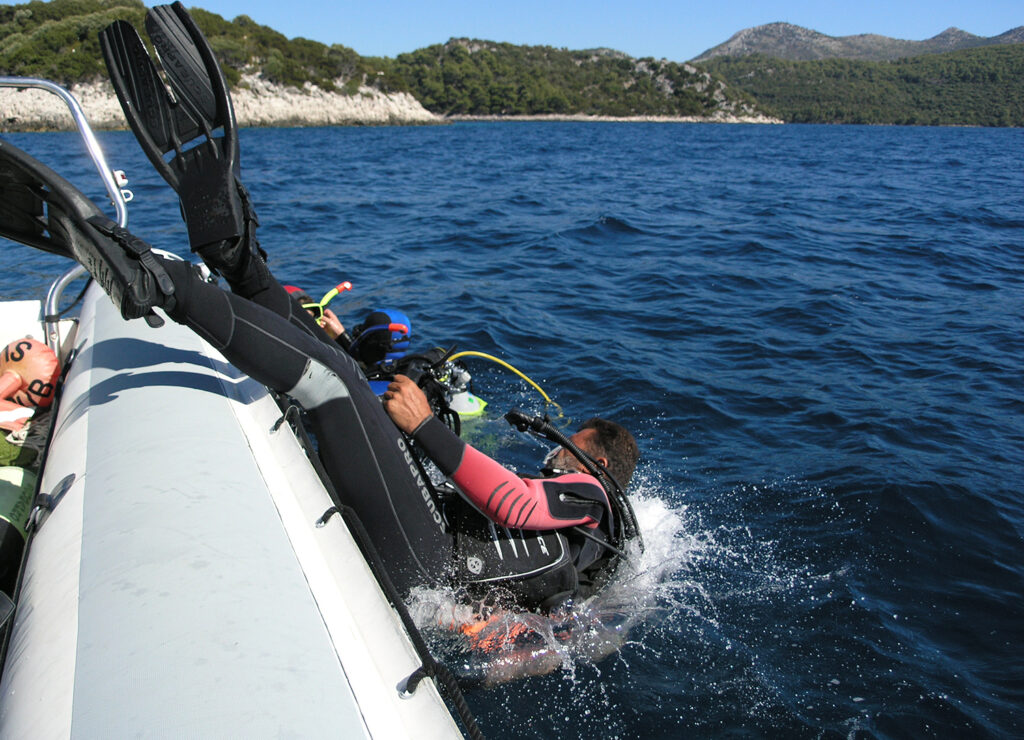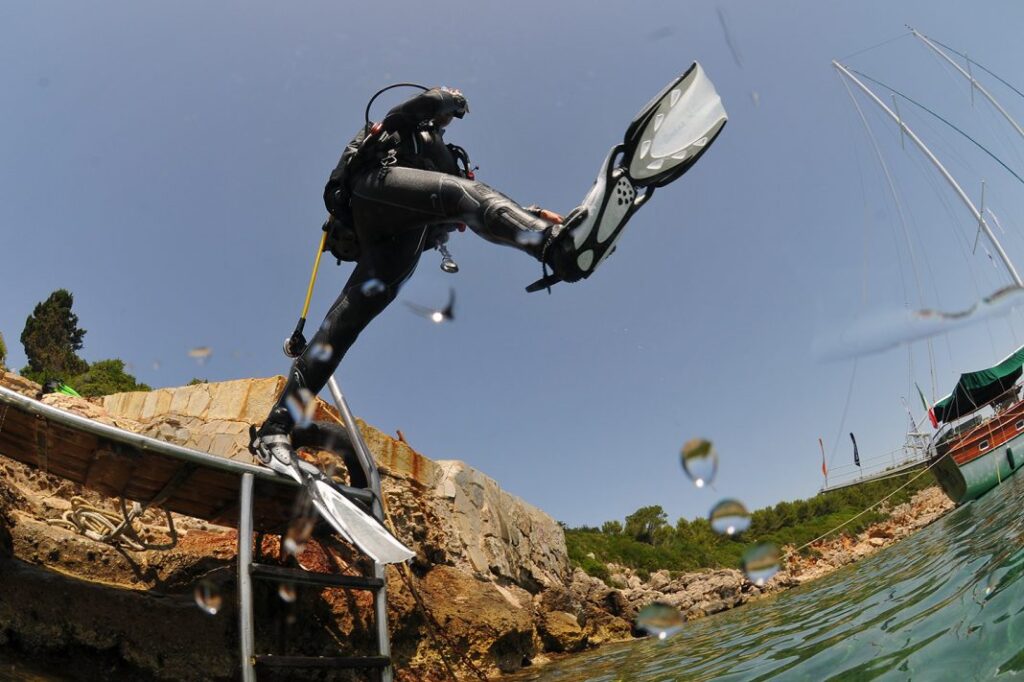There are various techniques for divers to enter the water, and the method you choose depends on your situation—whether you’re diving from the shore, a boat, dealing with currents (drift dive), or a boat…
Many divers don’t realize that there is a proper way to enter the water with diving equipment and believe they can simply jump in since they’ll end up there anyway. However, the consequences of improper water entry can be diverse and should not be overlooked. Flying fins are not an uncommon sight on diving trips. Poor preparation and a too-forceful jump often result in equipment loss. Poor execution of the jump is also a frequent cause of losing the diving mask. When you hit the water, the mask may fall off your face and quietly begin its descent to the depths, and you’ll realize something is missing when it’s already too late.
Sometimes, in diving locations, there is a strong sea current (drift dive), so you must quickly leave the boat – as soon as you get the captain’s green light (similar to jumping out of an airplane). Here and now—otherwise, you will miss the diving spot, the currents will take you to places you didn’t plan to be, causing problems for the entire team waiting for you in unfavorable conditions, or they may continue diving without you, and you’ll return to the boat. And all because you didn’t know how to jump into the water…
Sometimes, due to an irrational fear of falling, divers try to grab onto something in the final phase of the jump. It’s very easy to injure your fingers or even hit your head on the boat or platform from which you are jumping. Therefore, there are various ways to enter the water with diving equipment, and the choice depends on the situation (diving location). What is always important to note is to check (look) where you are jumping so that you don’t jump onto someone or something.

When entering the water from the shore, and you’re not elevated to just jump, put on all your diving equipment (except fins) and carefully step into deeper waters. Partially deflate your BCD and walk with the equipment on you and fins in hand until you reach a depth where you float (a suitable depth for swimming), and then you can fully inflate your BCD. The next step would be to put on the fins. Since you are floating (inflated buoyancy compensator), just lean back with the mask on your face and regulator in your mouth and slide the fins on one by one.
The method of walking with fins on your feet is not good at all, even if you plan to walk backward. Namely, you can easily fall, hit yourself, lose some equipment, or fall on someone behind you and seriously injure them!
The next method is used when the water is too shallow for a boat, ship, or shore jump, and your boat or platform almost touches the water’s surface and is all unstable. In this case, you need to equip yourself, put the regulator in your mouth, and sit on the edge of the platform. Use both hands to support yourself, then use both hands and legs (which are in the water with fins) to move forward – push yourself forward with your hands so that the diving tank does not hit the edge, and rotate in the air. Be careful that the valve assembly does not hit your head – do not fall into the water face-first!
When entering the water from a boat or elevated platform, put on all your diving equipment, put the mask on your face, and the regulator in your mouth. Get to the edge designated for water entry, check your equipment, and put on the fins there – do not walk on the boat or platform with fins on your feet! Inflate the buoyancy compensator and just step into the water, holding the mask and regulator pressed against your face with your hand (open palm). After entering the water, you will sink a bit and soon resurface – show the sign that everything is okay and move away from the spot where other divers will jump.

If you are diving in sea currents, you may arrange with the leader to jump with a deflated buoyancy compensator and immediately dive to the agreed depth, but everything else is identical.
The popular Back Roll, which looks attractive, is performed when entering the water from a rubber boat or a boat that does not have a specifically adapted platform for divers’ entry. To perform a back roll, put on all your diving equipment and sit on the edge of the boat facing the water. Put the mask on your face and the regulator in your mouth, holding them with your left hand, and deflate the buoyancy compensator. Hold the back of your head with your right hand so that you don’t hit the first stage of the regulator when you fall into the water. Then tilt your chin towards your chest and gently lean backward. You will do a small somersault and immediately surface, facing upward.

Show the sign that everything is okay and move away from the rubber boat so that no one jumps on you.
Some divers practice throwing an inflated buoyancy compensator, on which the diving tank and regulator are mounted, into the water (if the water is calm) and then jump and put on that compensator in the water. Of course, it’s possible, and it’s not complicated at all, but be careful that the equipment does not float away, arrange everything well on yourself, and check…
